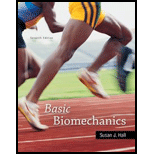
Basic Biomechanics
7th Edition
ISBN: 9780073522760
Author: Susan J Hall
Publisher: McGraw-Hill Education
expand_more
expand_more
format_list_bulleted
Concept explainers
Question
Chapter 7, Problem 6AP
Summary Introduction
To discuss: The importance of rotator cuff muscles as stabilizers of the glenohumeral joint and movers of the humerus.
Concept introduction: The glenohumeral joint is the major shoulder joint. It is a ball-and-socket joint that is formed by the articulation of humerus head with the glenoid fossa of the scapula.
Expert Solution & Answer
Want to see the full answer?
Check out a sample textbook solution
Chapter 7 Solutions
Basic Biomechanics
Ch. 7 - Construct a chart listing all muscles crossing the...Ch. 7 - Prob. 2IPCh. 7 - Prob. 3IPCh. 7 - INTRODUCTORY PROBLEMS 4. List the muscles that...Ch. 7 - INTRODUCTORY PROBLEMS 5. List the muscles used as...Ch. 7 - INTRODUCTORY PROBLEMS 6. Explain how the use of an...Ch. 7 - INTRODUCTORY PROBLEMS 7. Select a familiar...Ch. 7 - 8. Using the diagram in Sample Problem 7.1 as a...Ch. 7 - 10. Solve Sample Problem 7.2 with the addition of...Ch. 7 - Identify the sequence of movements that occur at...
Ch. 7 - Which muscles are most likely to serve as agonists...Ch. 7 - Prob. 3APCh. 7 - ADDITIONAL PROBLEMS 4. Which muscles are most...Ch. 7 - Prob. 5APCh. 7 - Prob. 6APCh. 7 - 8. How much tension (Fm) must be supplied by the...Ch. 7 - 9. What is the length of the moment arm between...Ch. 7 - Prob. 10AP
Knowledge Booster
Learn more about
Need a deep-dive on the concept behind this application? Look no further. Learn more about this topic, bioengineering and related others by exploring similar questions and additional content below.Similar questions
- Which of the following is a prime mover in head flexion? occipitofrontalis corrugator supercilii sternocleidomastoid masseterarrow_forwardWhat is the origin of the wrist flexors? the lateral epicondyle of the humerus the medial epicondyle of die humerus the carpal bones of the wrist the deltoid tuberosity of the humerusarrow_forwardBriefly define the types of joint movements available at a ball-and-socket joint.arrow_forward
- A shoulder separation results from injury to the ________. glenohumeral joint costoclavicular joint acromioclavicular joint sternoclavicular jointarrow_forwardDiscuss the structures that contribute to support of the shoulder joint.arrow_forwardA high ankle sprain iis an injury caused by over stretching the ligaments connecting the tibia and fibula. What type of joint iis involved in this sprain? ball and socket gomphosis syndesmosis symphysisarrow_forward
- Watch this video (http://openstaxcollege.org/l/flexext) to learn more about the flexion and extension of the knee, as the femur both rolls and glides on the tibia to maintain stable contact between the bones in all knee positions. The patella glides along a groove on the anterior side of the distal femur. The collateral ligaments on the sides of the knee become tight in the fully extended position to help stabilize the knee. The posterior cruciate ligament supports the knee when flexed and the anterior cruciate ligament becomes tight when the knee comes into full extension to resist hyperextension. What are the ligaments that support the knee joint?arrow_forwardWhich type of fibrous joint connects the tibia and fibula? syndesmosis symphysis suture gomphosisarrow_forwardWhich type of joint allows for only uniaxial movement? saddle joint hinge joint condyloid joint ball-and-socket jointarrow_forward
- The primary support for the glenohumeral joint is provided by the ________. coracohumeral ligament glenoid labium rotator cuff muscles subacromial bursaarrow_forwardWatch this video (http://openstaxcollege.org/l/anklejoint1) for a tutorial on the anatomy of the ankle joint. What are the three ligaments found on the lateral side of the ankle joint?arrow_forwardWhich muscles stabilize the pectoral girdle? axial and scapular axial appendicular axial and appendiculararrow_forward
arrow_back_ios
SEE MORE QUESTIONS
arrow_forward_ios
Recommended textbooks for you
- Understanding Health Insurance: A Guide to Billin...Health & NutritionISBN:9781337679480Author:GREENPublisher:Cengage
 Anatomy & PhysiologyBiologyISBN:9781938168130Author:Kelly A. Young, James A. Wise, Peter DeSaix, Dean H. Kruse, Brandon Poe, Eddie Johnson, Jody E. Johnson, Oksana Korol, J. Gordon Betts, Mark WomblePublisher:OpenStax College
Anatomy & PhysiologyBiologyISBN:9781938168130Author:Kelly A. Young, James A. Wise, Peter DeSaix, Dean H. Kruse, Brandon Poe, Eddie Johnson, Jody E. Johnson, Oksana Korol, J. Gordon Betts, Mark WomblePublisher:OpenStax College  Fundamentals of Sectional Anatomy: An Imaging App...BiologyISBN:9781133960867Author:Denise L. LazoPublisher:Cengage Learning
Fundamentals of Sectional Anatomy: An Imaging App...BiologyISBN:9781133960867Author:Denise L. LazoPublisher:Cengage Learning Biology 2eBiologyISBN:9781947172517Author:Matthew Douglas, Jung Choi, Mary Ann ClarkPublisher:OpenStax
Biology 2eBiologyISBN:9781947172517Author:Matthew Douglas, Jung Choi, Mary Ann ClarkPublisher:OpenStax Biology (MindTap Course List)BiologyISBN:9781337392938Author:Eldra Solomon, Charles Martin, Diana W. Martin, Linda R. BergPublisher:Cengage Learning
Biology (MindTap Course List)BiologyISBN:9781337392938Author:Eldra Solomon, Charles Martin, Diana W. Martin, Linda R. BergPublisher:Cengage Learning

Understanding Health Insurance: A Guide to Billin...
Health & Nutrition
ISBN:9781337679480
Author:GREEN
Publisher:Cengage

Anatomy & Physiology
Biology
ISBN:9781938168130
Author:Kelly A. Young, James A. Wise, Peter DeSaix, Dean H. Kruse, Brandon Poe, Eddie Johnson, Jody E. Johnson, Oksana Korol, J. Gordon Betts, Mark Womble
Publisher:OpenStax College


Fundamentals of Sectional Anatomy: An Imaging App...
Biology
ISBN:9781133960867
Author:Denise L. Lazo
Publisher:Cengage Learning

Biology 2e
Biology
ISBN:9781947172517
Author:Matthew Douglas, Jung Choi, Mary Ann Clark
Publisher:OpenStax

Biology (MindTap Course List)
Biology
ISBN:9781337392938
Author:Eldra Solomon, Charles Martin, Diana W. Martin, Linda R. Berg
Publisher:Cengage Learning